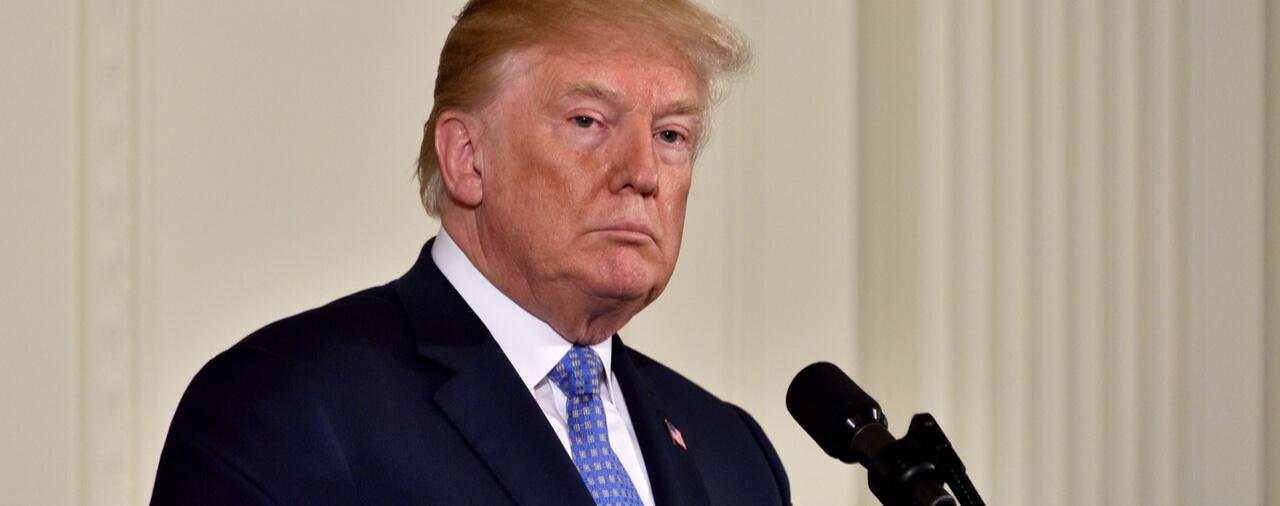Introduction
Late in the afternoon on January 27, 2017, President Donald Trump issued an executive order (EO) titled “Protecting the Nation from Foreign Terrorist Entry into the United States” (82 FR 8977 (Jan. 27, 2017)) [PDF version]. The two most prominent provisions of the EO — those dealing with suspending refugee admissions and processing for 120 days (and suspending processing from Syria until further notice from the President) and those suspending entry by nationals from seven countries — have become national news. The debate over the EO has focused both on its contents and on its slipshod implementation by the executive branch. Subsequent to the issuance of the EO, many federal district courts have weighed in on the matter, staying the EO’s implementation against lawful permanent residents (LPRs) (the WH reinterpreted the EO as not applying to LPRs). On February 3, 2017, the United States District Court for the Western District of Washington issued a temporary restraining order (TRO) against the EO in its entirety, finding that the State of Washington had standing to bring the suit and ruling that it was likely to prevail on the merits [PDF version]. The matter is currently (as of February 5, 2017) pending before the United States Court of Appeals for the Ninth Circuit, and it may soon end up before the Supreme Court of the United States.
Between the initially muddled implementation of the EO, inaccurate media reports, and the number of provisions of immigration law cited, it can be hard to separate fact from fiction for experts and laymen alike. In this article, I will examine the controversial portions of the EO and explore and their legal basis as written and in the immigration laws. After reading this post, please see my second post on whether the provisions of the EO represent good law and policy [see blog]. I will not discuss the ongoing litigation in this article, but I will address that in separate posts.
Provisions Relating to Suspension of Immigrant and Nonimmigrant Entry for Certain Countries
The first controversial part of the EO relates to the suspension of visa issuance and entry for nationals of certain countries. To understand, let us look at the relevant portions of the EO itself.
First, this is excerpted from section 3(c) of the EO:
pursuant to section 212(f) of the INA, 8 U.S.C. 1182(f), I hereby proclaim that the immigrant and nonimmigrant entry into the United States of aliens from countries referred to in section 217(a)(12) of the INA, 8 U.S.C. 1187(a)(12), would be detrimental to the interests of the United States, and I hereby suspend entry into the United States, as immigrants and nonimmigrants, of such persons for 90 days from the date of this order (excluding those foreign nationals traveling on diplomatic visas, North Atlantic Treaty Organization visas, C-2 visas for travel to the United Nations, and G-1, G-2, G-4, and G-4 visas).
The President ordered the Secretary of Homeland Security, Secretary of State, and Director of National Intelligence to compile within 30 days the information needed from individual countries to vet aliens from such countries seeking entry (see 3(a) and (b)). Section 3(c) suspends “immigrant and nonimmigrant entry into the United States” of aliens from certain countries in order to “temporarily reduce investigative burdens on relevant agencies during the review period.” Section 3(e) requires that the Secretary of Homeland Security, in conjunction with the Secretary of State, provide the President with a list of countries that do not provide certain information for inclusion on the list of countries with visa restrictions. This would occur in 90 days from the date of the order.
The following is excerpted from section 3(g) of the EO:
Notwithstanding a suspension pursuant to subsection (c) of this section or pursuant to a Presidential proclamation described in subsection (e) of this section, the Secretaries of State and Homeland Security may, on a case-by-case basis, and when in the national interest, issue visas or other immigration benefits to nationals of countries for which visas and benefits are otherwise blocked.
Subsection (g) thereby authorizes the Secretary of State and the Secretary of Homeland Security to grant benefits to individuals otherwise barred by the President’s exercise of section 212(f) of the INA in subsections (c) and (e). However, such benefits may only be granted on a “case-by-case basis” if it is determined to be in the “national interest.”
Provisions Relating to Refugees
Section 5 of President Trump’s EO deals with the United States Refugee Admissions Program for Fiscal Year 2017. Section 5(a) directs the Secretary of State to suspend the U.S. Refugee Admissions Program (USRAP) for 120 days and in that period to conduct a review of the USRAP in conjunction with the Secretary of Homeland Security and the Director of National Intelligence. The review will be to determine “what additional procedures should be taken to ensure that those approved for refugee admission do not pose a threat to the security and welfare of the United States.” Section 5(a) allows for refugee applicants who are already in the USRAP to be admitted under whatever revised procedures are implemented after the 120-day period. After the 120-day period, only refugees from countries that the Secretary of State, Secretary of Homeland Security, and Director of National Intelligence have determined do not pose a threat to the welfare and security of the United States with the new procedures implemented after the 120-day period.
Section 5(b) of the EO instructs the Secretary of State, in conjunction with the Secretary of Homeland Security, to prioritize refugee claims made by individuals on the basis of religious-based persecution provided that the religion of the individuals “is a minority religion in the individual’s country of nationality.” The EO specifically instructs that these changes be made “to the extent permitted by law,” but orders the Secretaries of State and Homeland Security to recommend legislation to the President “that would assist with such prioritization.”
In section 5(c) of the EO, President Trump proclaimed that the entry of nationals of Syria is detrimental to the interests of the United States. The President stated that this suspension would be in effect until he determines that the changes made to USRAP ensure that the admission of Syrian refugees is consistent with the interests of the United States.
In section 5(d), President Trump again used section 212(f), proclaiming that the entry of more than 50,000 refugees in FY-2017 would be detrimental to the United States. This reduces the target set by the Obama Administration, which had been 110,000. However, the cap of 50,000 is consistent with the early years of the Obama Administration and the George W. Bush Administration.
In section 5(e), President Trump allowed for waivers to be issued on a case-by-case basis by the Secretaries of State and Homeland Security for refugees for whom the entry is determined to be in the national interest. This provision specifies refugees who are religious minorities in their country of nationality applying for status on the basis of religious persecution. It also specifies refugees who are already in transit and individuals who are coming on the basis of a preexisting international agreement.
Which Countries Are Included and Why?
The President’s list of countries derives from section 212(a)(12) of the Immigration and Nationality Act (INA). In December of 2015, the Senate promulgated section 212(a)(12) to single out nationals of certain countries of concern as being ineligible for the Visa Waiver Program (VWP) due to security concerns. Section 212(a)(12) initially covered Iran, Iraq, Sudan, and Syria. We discussed the provision on site when it was passed [see article]. On February 18, 2016, the Department of Homeland Security (DHS) added Libya, Somalia, and Yemen to the list of countries under section 212(a)(17)(ii)(III) [link].
In short, President Trump chose countries that had previously been designated as countries of concern by Congress and by the President for purpose of restricting VWP eligibility. Under subsection (e) of the order, the President reserves the right to add countries beyond those already designated under section 212(a)(17). However, as an initial matter, the President restricted the EO to these countries already designated.
Many have noted that there are other countries in the Middle East and in Central Asia that would seem to pose similar terror risks to the ones designated by the President. It is likely the President decided he would be on more solid footing with an initial designation of countries that Congress and the previous Administration had already found to be countries of concern, and he reserved whether to subtract or add any countries to the list pending further evidence.
The President’s Authority Under 212(f)
The President issued his proclamation restricting immigration from certain countries under section 212(f) of the INA. Section 212(f) reads as follows:
Whenever the President finds that the entry of any aliens or of any class of aliens into the United States would be detrimental to the interests of the United States, he may by proclamation, and for such period as he shall deem necessary, suspend the entry of all aliens or any class of aliens as immigrants or nonimmigrants, or impose on the entry of aliens any restrictions he may deem to be appropriate. Whenever the Attorney General finds that a commercial airline has failed to comply with regulations of the Attorney General relating to requirements of airlines for the detection of fraudulent documents used by passengers traveling to the United States (including the training of personnel in such detection), the Attorney General may suspend the entry of some or all aliens transported to the United States by such airline.
Section 212(f) thus gives the President broad authority to suspend or restrict the entry of any aliens or a class of aliens when he or she deems that the entry of said aliens or such class of aliens would be detrimental to the interests of the United States. The construction of the statute seemingly appears to give the President sweeping authority to issue proclamations under section 212(f). Before continuing, I encourage you to see our full article on the structure and history of section 212(f) as a reference for the rest of this article [see article].
Use of Presidential Proclamations in the Past
Section 212(f) has been invoked by every president going back to Ronald Reagan. President Trump’s EO marks the 44th time it has been used since 1981. None of the 43 proclamations issued under section 212(f) prior to President Trump’s sweep as broadly as his does, however. The closest in scope is perhaps the very first, issued by President Ronald Reagan.
On September 29, 1981, President Reagan issued Proclamation 4865-High Seas Interdiction of Illegal Aliens (48 FR 48107). President Reagan found the entry of undocumented aliens arriving at the borders of the United States from the high seas to be detrimental to the interests of the United States. Accordingly, President Reagan suspended the entry of undocumented aliens arriving from the high seas and ordered the interdiction of “certain vessels carrying such aliens.”
To see a list of all of the proclamations issued under section 212(f) by Presidents Reagan, G.H.W. Bush, Clinton, G.W. Bush, and Obama, please see pages 6-10 of the linked report composed by the Congressional Research Report [PDF version].1
Conclusion
In this post, I offered a brief overview of the legality of the provisions of the EO. To learn more about the key statute, please make sure to see our full article on section 212(f) of the INA. I look forward to examining some of the complex legal questions in subsequent blog posts and updates about the ongoing litigation surrounding the EO. Please see my companion blog post for analysis of the EO from a policy perspective, and why I think the EO as written mostly constitutes good policy separate from its haphazard implementation [see blog].





